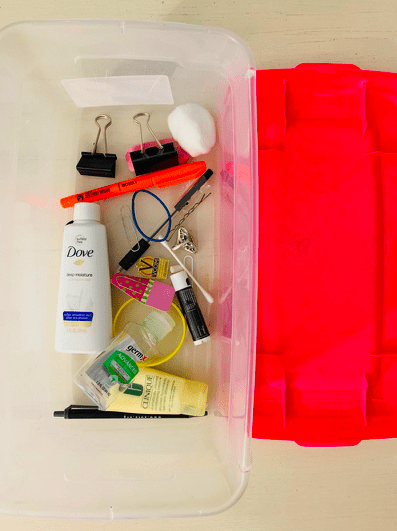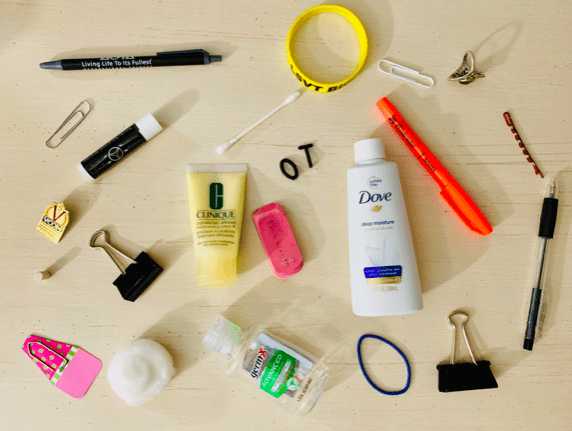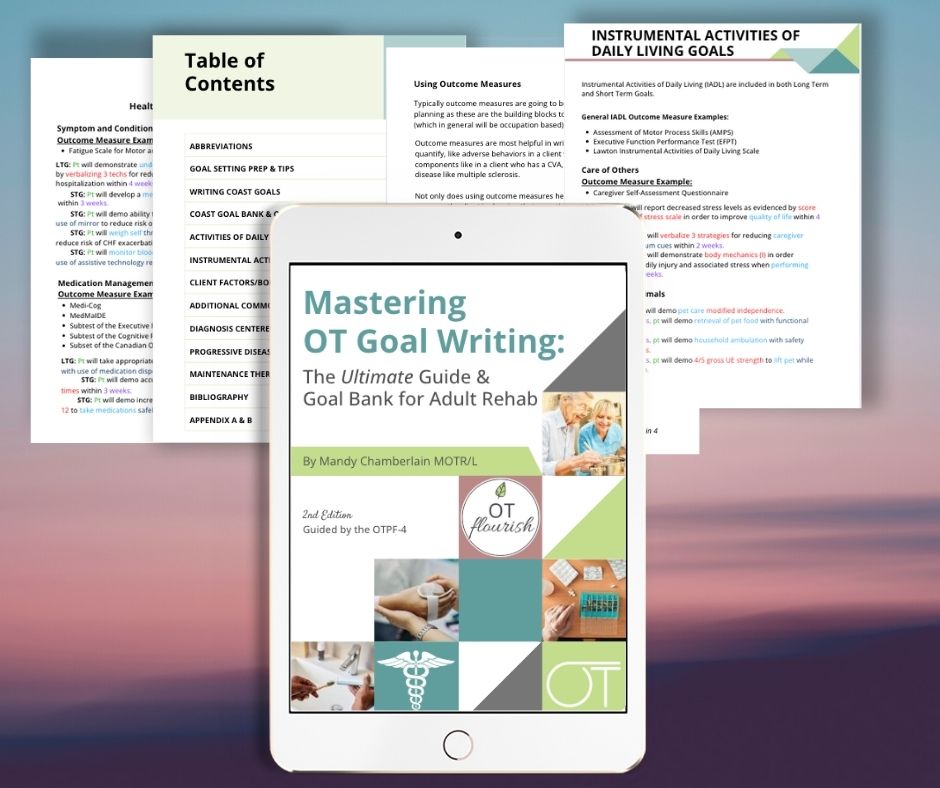Stereognosis involves using your tactile discrimination and touch perception skills to identify and recognize an object or group of objects with vision occluded; in other words stereognosis is when your fingers essentially “read” between the objects of different textures, temperatures, sizes, shapes, and weights and send information to your brain to figure out which of the objects is THE OBJECT (such as your favorite lipstick in your makeup bag) to retrieve – a part of your sensation.
In Part 1 of this 3-part article series, we dived into the “who”, “what”, “when”, “where”, and “why” about stereognosis and what it has to do with occupational therapy and adults. In this Part 2, we will go over the “how” to incorporate a stereognosis test and assessment into your OT evaluation. Then in Part 3 of the series, we will dive into how to grade down and grade up stereognosis therapeutic activities into multifaceted OT interventions.
First things, first if you have not read Part 1 go back and do that by clicking here. Then, gather and build your own kit to make a stereognosis test like this one pictured below with items found around the clinic and home.
Next, continue reading for the “how to” run through!

How to Perform a Stereognosis Test
There are multiple ways to get stereognosis test results from your patient. Two informal tests, in addition to your standardized OT assessments, with vision occluded (i.e. without looking; using tactile sensation only) include:
- Test A (Identification of a specific object that is placed in patient’s hand) and/or
- Test B (Identification of a specific object from a group of objects).
Prior to engaging the patient in either or both of the tests it is imperative to explain what you will be testing and why it matters to that specific patient. Best practice to ensure patient understanding is for the therapist or student therapist to demonstrate on oneself first.
You may ask the patient to place any object into your hand and without looking and verbalize what the object is to the patient. Likewise, you may instruct the patient to choose 5 objects to place in a small container followed by you the therapist closing eyes and reaching into the container to identify an item of the patient’s discretion using touch sense only.
Let’s move on to the specifics of the test.
If the patient is still having some difficulty in understanding how to participate then instruct the patient to perform the test first with his or her eyes open using both visual and tactile perception to comprehend the how to before moving on to assessing without use of visual input.

Stereognosis Assessment Test A: Identification of a Specific Stimulus that is Placed in Patient’s hand
Step by Step: Therapist chooses # of stimulus to test less impaired hand followed by more impaired hand.
Actions: Choose 5 items such as a paper clip, a marble, a binder clip, a rubber band, and a penny
Therapist provides overview of stereognosis which includes going over instructions, giving different explanations, and providing demonstrations as needed.
A patient specific / client centered intro is provided.
Therapist provides a demonstration oneself as needed for the patient’s understanding of the stereognosis test.
Insert an intro scenario that is relative to your patient such as “Since you have told me that you are having trouble finding the buttonhole of your pants, I would like to test how you do with different items in using your touch sense to choose one over the other. We will keep track of the progress accuracy and work on this skill because I know it is important to you to be able to button your pants independently”.
We then demonstrates oneself first and then instructs patient to close eyes and hold out less impaired hand with palm up and hands open.
Therapist places stimulus in hand and asks for identification. Repeat process 5x or desired number of trials. Therapist places one stimulus at a time in patient’s hand and asks, “Without opening your eyes, please tell me what item I placed into your hand.”
Repeat action above for each additional stimulus (performing all of less impaired hand followed by more impaired hand as noted on Step 5).
Therapist records number of seconds patient required to answer as well as marks for accuracy and specific hand
Ex paper recording: *On scratch paper: “R | y7s, y5s, y6s, n, y7s (y=yes, n=no, s=#of seconds) “ which translates to “Using Right less impaired hand patient scored 80% accuracy in an average of approx. 6 seconds”
Ex narrative documentation: With his nonaffected right hand, patient achieved 80% accuracy with an avg of 6 secs each in identifying 4 out of 5 unfamiliar objects during stereognosis training to improve his ability to button his pants”
Repeat Steps above on more impaired hand for comparison. Document the discrepancies especially detailing if one hand shows significant changes from the other hand. Determine importance of including stereognosis training into future interventions.

Stereognosis Assessment Test B: Identification of a Specific Stimulus from a Group of Objects
Step by Step: Therapist chooses # of stimulus to place into a container to test less impaired hand followed by more impaired hand. Therapist discerns the size of container that will hold the group of objects
Actions: Choose about 10 -15 small items such as a paper clip, a marble, a binder clip, a rubber band, a penny, etc into small container.
Therapist provides overview of the stereognosis test, which includes going over instructions, giving different explanations, and providing demonstrations as needed. A patient specific / client centered intro is provided.
Therapist provides a demonstration oneself as needed for patient’s understanding.
Insert an intro scenario that is relative to your patient such as “I know it bothers you that you have to ask your friend at church to help you you’re your car keys out of your bag instead of you loudly dumping the contents of the bag out…so I would like to test how you do with finding different objects using your hands only to feel in this bin so that we can make a plan for how we will work on this skill together and keep track of the progress.”
Therapist instructs patient to close eyes and reach into the bin with his or her right hand to find a verbalized stimulus. Repeat process 5x or desired number of trials.
“Using your right hand only find and take out the paper clip from the bin.”
Therapist records number of seconds patient required to distinguish specific stimulus from other objects in the bin. Therapist records the accuracy. Ex paper recording:
Ex paper recording:
*On scratch paper: “L | y60s, n, n, n, y40s (y=yes correctly identifies, n=no, does not or incorrectly identifies, s=#of seconds) “which translates to “Using left impaired hand patient scored 40% accuracy in an average of approx. 50 seconds”
Ex narrative documentation:
With minimal tactile cueing, patient retrieved 2 out of 5 indicated items out of a container of 15 items in an average of 50 seconds per trial during stereognosis training with use of affected left hand in order to improve ability to find car keys out of her purse in a timely manner.
Repeat Steps above on the other hand for comparison. Document the discrepancies especially detailing if one hand shows significant changes from the other hand. Determine importance of including stereognosis training into future interventions.

Documentation:
It is important to note that you the practitioner or student practitioner need to record the accuracy of the stereognosis test in order to track the patient’s progress between sessions. Use what works best for you to keep track of number of trials, specific objects that are more or less difficult to differentiate, and which test method is used.
Other documentation ex:
With minimal tactile cueing patient performed stereognosis training with 60% accuracy in identifying 3 out of 5 familiar household items using her left surgical side to increase her ability to discriminate between her makeup brushes during her ADL morning grooming routine.
Ready to learn HOW to grade down or grade up stereognosis activities in treatment? Check it out in the next article in this stereognosis series!
About our guest blogger
Shannen Marie Coley, MS, OTR/L is an occupational therapist that is passionate about adult inpatient rehabilitation, patient wellness, professional development, advocacy, and occupational balance. She is an LSVT BIG certified clinician since 2018. Since graduating OT school in December 2016, Shannen has worked in the hospital and inpatient rehab settings serving adult patients of variable backgrounds, stories, and upbringings with a variety of neurological, cardiopulmonary, orthopedic diagnoses. Shannen enjoys writing and sharing tidbits of OT related stories on her blog ShannenMarieOT.com and is active on Instagram (IG) @shannenmarie_ot. Shannen is married to her college sweetheart and they have one child – a six toed cat named Gravy.




